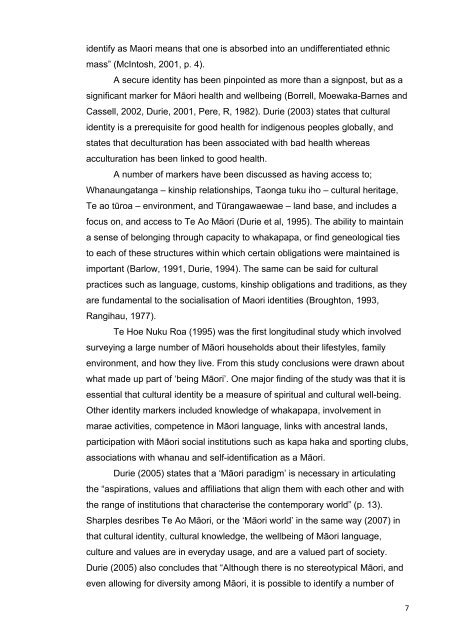Te Māoritanga WELLBEING AND IDENTITY Kapa Haka as a Vehicle
Te Māoritanga WELLBEING AND IDENTITY Kapa Haka as a Vehicle
Te Māoritanga WELLBEING AND IDENTITY Kapa Haka as a Vehicle
You also want an ePaper? Increase the reach of your titles
YUMPU automatically turns print PDFs into web optimized ePapers that Google loves.
identify <strong>as</strong> Maori means that one is absorbed into an undifferentiated ethnic<br />
m<strong>as</strong>s” (McIntosh, 2001, p. 4).<br />
A secure identity h<strong>as</strong> been pinpointed <strong>as</strong> more than a signpost, but <strong>as</strong> a<br />
significant marker for Māori health and wellbeing (Borrell, Moewaka-Barnes and<br />
C<strong>as</strong>sell, 2002, Durie, 2001, Pere, R, 1982). Durie (2003) states that cultural<br />
identity is a prerequisite for good health for indigenous peoples globally, and<br />
states that deculturation h<strong>as</strong> been <strong>as</strong>sociated with bad health where<strong>as</strong><br />
acculturation h<strong>as</strong> been linked to good health.<br />
A number of markers have been discussed <strong>as</strong> having access to;<br />
Whanaungatanga – kinship relationships, Taonga tuku iho – cultural heritage,<br />
<strong>Te</strong> ao tūroa – environment, and Tūrangawaewae – land b<strong>as</strong>e, and includes a<br />
focus on, and access to <strong>Te</strong> Ao Māori (Durie et al, 1995). The ability to maintain<br />
a sense of belonging through capacity to whakapapa, or find geneological ties<br />
to each of these structures within which certain obligations were maintained is<br />
important (Barlow, 1991, Durie, 1994). The same can be said for cultural<br />
practices such <strong>as</strong> language, customs, kinship obligations and traditions, <strong>as</strong> they<br />
are fundamental to the socialisation of Maori identities (Broughton, 1993,<br />
Rangihau, 1977).<br />
<strong>Te</strong> Hoe Nuku Roa (1995) w<strong>as</strong> the first longitudinal study which involved<br />
surveying a large number of Māori households about their lifestyles, family<br />
environment, and how they live. From this study conclusions were drawn about<br />
what made up part of ‘being Māori’. One major finding of the study w<strong>as</strong> that it is<br />
essential that cultural identity be a me<strong>as</strong>ure of spiritual and cultural well-being.<br />
Other identity markers included knowledge of whakapapa, involvement in<br />
marae activities, competence in Māori language, links with ancestral lands,<br />
participation with Māori social institutions such <strong>as</strong> kapa haka and sporting clubs,<br />
<strong>as</strong>sociations with whanau and self-identification <strong>as</strong> a Māori.<br />
Durie (2005) states that a ‘Māori paradigm’ is necessary in articulating<br />
the “<strong>as</strong>pirations, values and affiliations that align them with each other and with<br />
the range of institutions that characterise the contemporary world” (p. 13).<br />
Sharples desribes <strong>Te</strong> Ao Māori, or the ‘Māori world’ in the same way (2007) in<br />
that cultural identity, cultural knowledge, the wellbeing of Māori language,<br />
culture and values are in everyday usage, and are a valued part of society.<br />
Durie (2005) also concludes that “Although there is no stereotypical Māori, and<br />
even allowing for diversity among Māori, it is possible to identify a number of<br />
7
















